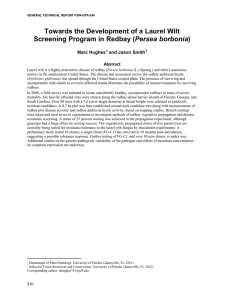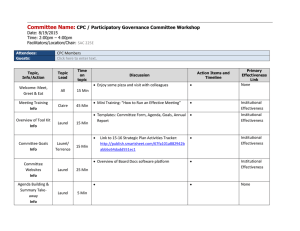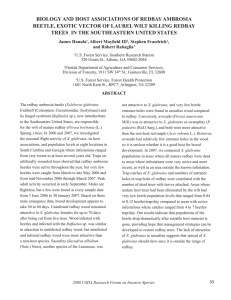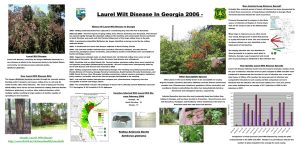dorsal view of adult Xyleborus glabratus Eichhoff beetles. The redbay ambrosia beetle
advertisement
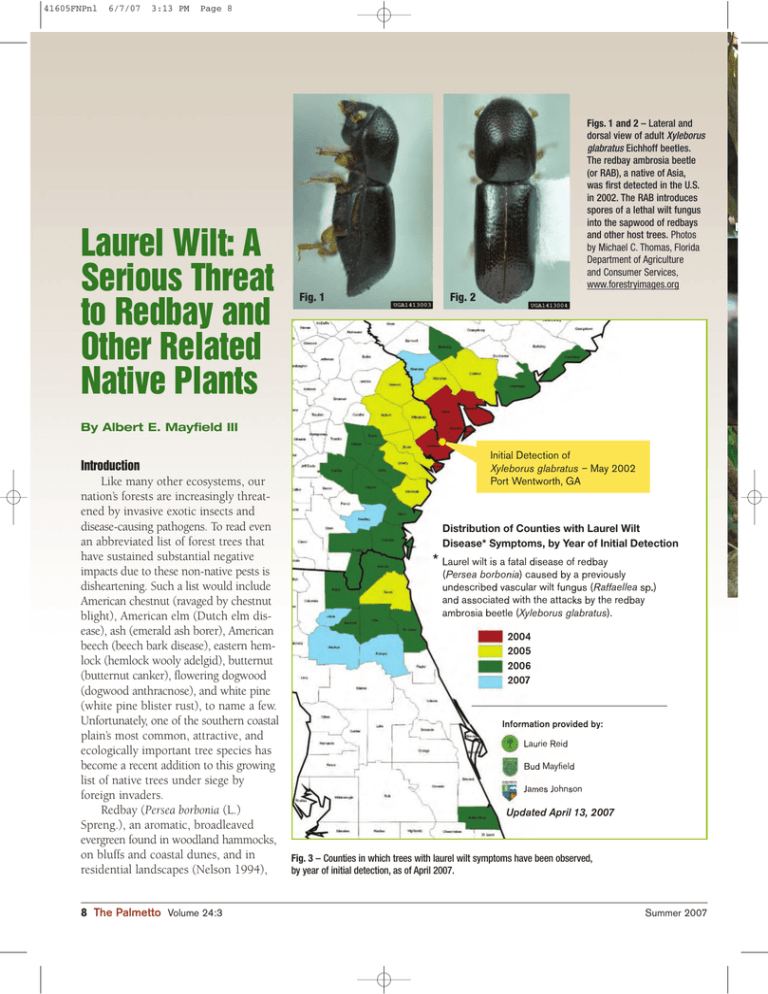
41605FNPnl 6/7/07 3:13 PM Page 8 Laurel Wilt: A Serious Threat to Redbay and Other Related Native Plants Fig. 1 Figs. 1 and 2 – Lateral and dorsal view of adult Xyleborus glabratus Eichhoff beetles. The redbay ambrosia beetle (or RAB), a native of Asia, was first detected in the U.S. in 2002. The RAB introduces spores of a lethal wilt fungus into the sapwood of redbays and other host trees. Photos by Michael C. Thomas, Florida Department of Agriculture and Consumer Services, www.forestryimages.org Fig. 2 By Albert E. Mayfield III Initial Detection of Introduction Xyleborus glabratus – May 2002 Port Wentworth, GA Like many other ecosystems, our nation’s forests are increasingly threatened by invasive exotic insects and disease-causing pathogens. To read even Distribution of Counties with Laurel Wilt an abbreviated list of forest trees that Disease* Symptoms, by Year of Initial Detection have sustained substantial negative a rel wilt i a fatal i ea e of re ay impacts due to these non-native pests is ersea borbo a ca e y a re io ly disheartening. Such a list would include n e cri e a c lar wilt f n a aellea an a ociate with the attac y the re ay American chestnut (ravaged by chestnut a ro ia eetle Xyleborus glabratus blight), American elm (Dutch elm disease), ash (emerald ash borer), American 2004 beech (beech bark disease), eastern hem2005 lock (hemlock wooly adelgid), butternut 2006 (butternut canker), flowering dogwood 2007 (dogwood anthracnose), and white pine (white pine blister rust), to name a few. Unfortunately, one of the southern coastal Information provided by: plain’s most common, attractive, and a rie ei ecologically important tree species has become a recent addition to this growing Mayfiel list of native trees under siege by a e ohn on foreign invaders. Redbay (Persea borbonia (L.) Updated April 13, 2007 Spreng.), an aromatic, broadleaved evergreen found in woodland hammocks, on bluffs and coastal dunes, and in Fig. 3 – Counties in which trees with laurel wilt symptoms have been observed, residential landscapes (Nelson 1994), by year of initial detection, as of April 2007. 8 The Palmetto Volume 24:3 Summer 2007 Fig. 41605FNPnl 6/7/07 3:13 PM Page 9 Fig. 4 – Trees diseased with laurel wilt initially exhibit drooping foliage with a reddish or purplish discoloration. Figs. 5 and 6 – Trees affected by laurel wilt exhibit a dark, blackish stain in the sapwood. Fig. 7 – As the tree dies from fungal infection and is colonized by more ambrosia beetles, toothpick-like tubes or piles of fine sawdust may be observed on the bark. Photos by Albert (Bud) Mayfield, Florida Department of Agriculture and Consumer Services, www.forestryimages.org. Fig. 4 Fig. 5 Fig. 6 Fig. 7 is being severely impacted by a new disease called laurel wilt. Laurel wilt is caused by a previously undescribed vascular fungus (Raffaelea sp.) that colonizes the sapwood of its host tree, restricting water flow and causing the tree to wilt and die. This fungus is vectored by an Asian wood-boring insect, the redbay ambrosia beetle (Xyleborus glabratus Eichhoff ), or “RAB”. [Figs. 1 and 2] The RAB was first detected in a survey trap at Port Wentworth, Georgia (near Savannah) in 2002, but its association with the unusual and excessive redbay mortality occurring in that region was not recognized until late 2004 (Fraedrich et al. 2006). Since then, laurel wilt and associated redbay mortality has been detected in more than 33 counties in South Carolina, Georgia, and Florida. The distribution of this lethal disease is likely to continue to expand. [Fig.3 ] Trees become infected with the laurel wilt fungus when RABs bore into the sapwood. In general, ambrosia beetles are fungus farmers: they create tunnels in the wood of host trees, inoculate those tunnels with fungal spores they carry on their bodies, and propagate the fungus as food. Most native ambrosia beetles are limited to dead, injured, or weakened trees (Wood 1982) and generally are not known to be disease vectors or pests of healthy trees. As an exotic insect in North America, however, the RAB is colonizing apparently healthy redbay trees in a wide variety of habitats, and its associated wilt fungus is functioning as an aggressive plant pathogen. The RAB is one of at least 25 new species of bark and woodboring beetle species introduced into the U.S. since 1985, most of which are believed to have arrived accidentally in untreated solid wood packing material, such as crates and pallets used in international trade (Haack 2006). Symptoms Trees diseased with laurel wilt initially exhibit drooping foliage with a reddish or purplish discoloration. [Fig 4] This discoloration may occur in a portion the crown at first, but gradually the entire crown wilts and reddens. The foliage eventually turns brown and may remain on the branches for up to a year or more. Stem cross sections and removal of bark from wilted trees reveals a dark, blackish stain in the sapwood. [Figs. 5 and 6] The extent of this black staining (a response of the tree to the fungal infection) varies depending on how long the tree has been infected. In the early stages of disease, an affected redbay may not show any obvious signs of ambrosia beetle attack, even though the tree has already been attacked and inoculated with the wilt fungus. Presumably, very few RABs are needed to successfully inoculate the tree; these early attacks are inconspicuous and may happen on branches in the crown or on the stem. Eventually, as the tree dies from fungal infection and is colonized by more ambrosia beetles, toothpick-like tubes or piles of fine sawdust may be observed on the bark. [Fig. 7] This dust is produced by the RAB and multiple other species of ambrosia beetles that colonize the dead tree. Impact on Redbay In areas where the RAB has been established for several years, the impact of laurel wilt on populations of mature redbay trees has been devastating. In plots monitored on Fort George Island, Duval County, Florida, redbay mortality associated with laurel wilt increased from 10% to 92% in just CONTINUED ON PAGE 10 Summer 2007 Volume 24:3 The Palmetto 9 41605FNPnl 6/7/07 3:13 PM Page 10 residential neighborhoods, parks, and recreational areas. The visual impact of laurel wilt in a forest or neighborhood where redbay is abundant is striking. Although difficult to quantify, the losses associated with widespread mortality of redbay due to laurel wilt are numerous and diverse. Fig. 8 – Leaves of redbay and other Persea species are the primary food source for larvae of the palamedes swallowtail butterfly. Photo by Johnny N. Dell, Retired, www.forestryimages.org 15 months, including the death of all redbays over four inches in diameter (A.E. Mayfield and J.M. Eickwort, Florida DACS, unpublished data). Similarly high levels of redbay mortality from other areas of coastal South Carolina and Georgia have been reported by state forest health staff (J. Johnson, Georgia Forestry Commission, and L. Reid, South Carolina Forestry Commission, personal communication). Interestingly, seedlingsized redbays appear to be less affected by the disease, presumably because they are not as readily colonized by the RAB. Whether this will continue to be the case, or whether there will be any natural disease resistance in mature redbay populations, remains to be seen. Although not prized for its timber, redbay is a species of notable ecological, cultural, and aesthetic value. Redbay produces annual crops of berry-like drupes that are eaten by songbirds, wild turkeys, quail, rodents, deer, and black bear (Brendemuehl 1990, Coder 2006). In addition to serving as winter browse for deer, leaves of Persea species are the primary larval food source for the palamedes swallowtail butterfly (Papilio palamedes (Drury)) (Hall and Butler 2005). [Fig. 8] Cultural uses of redbay have included its wood for trim on boats and cabinets, its leaves for flavoring teas and gumbos, and various plant parts for the medicinal purposes of Native Americans (Coder 2006). Although commonly a small to medium-sized understory tree, redbay can reach 70 feet in height (Brendemuehl 1990) and is an important shade tree in some 10 The Palmetto Volume 24:3 Other Host Species In addition to causing epidemic levels of redbay mortality, laurel wilt has also been confirmed in the field affecting other species in the family Lauraceae, including sassafrass (Sassafras albidum (Nuttall) Nees), pondspice (Litsea aestivalis (L.) Fernald), and the endangered pondberry (Lindera melissifolia (Walter) Blume) (Fraedrich et al. 2006). Laboratory tests have also demonstrated the pathogenicity of the wilt fungus on spicebush (Lindera benzoin (L.) Blume) and swamp bay (Persea palustris (Raf.) Sarg.) (Fraedrich et al. 2006). In addition, both the RAB and the laurel wilt pathogen have been recovered from diseased avocado (Persea americana Mill.) seedlings planted near Jacksonville for monitoring purposes. What the impact of laurel wilt will be on these and other Lauraceous species is uncertain, but the growing list of hosts seems to warrant concern for other members of this important and diverse plant family. Management Unfortunately, management options for laurel wilt are very limited, and at this time there are no strategies that have actually been demonstrated as effective in preventing or reducing disease impact. The following are suggested as potential management tactics, based on approaches employed for similar wilt diseases of other trees (e.g., Dutch elm disease): Avoid transport of infested wood. Perhaps the best short-term option for reducing (or at least delaying) the impact of laurel wilt is to help limit its spread, particularly by preventing human-aided transport of wood infested with the RAB. Although the RAB is undoubtedly spreading naturally via flight, geographically isolated occurrences of the disease (like the discoveries in Duval County in 2005 and Indian River County in 2006) suggest that the beetle may also be reaching new, distant areas via human-aided travel. Firewood, logs, other intact wood, or nursery stock of wilted Lauraceous trees should not be transported to unaffected areas. [Fig. 9] Sanitation. The goal of sanitation is to destroy infected host trees before brood populations of the RAB emerge from them and spread to new host trees, thereby reducing or delaying the overall mortality level in a local area. This treatment would involve cutting and burning, burying, chipping, or tightly covering wood from wilted trees. Although individual beetles may theoretically be able to survive a standard chipping process due to their small size (about 2 mm in length), chipping might sufficiently dry out the wood to prevent ambrosia beetle survival, development and subsequent dispersal. Summer 2007 41605FNPnl 6/7/07 3:13 PM Page 11 Florida plants in the family Lauraceae: • Redbay*– Persea borbonia Diseased trees that are cut but cannot be destroyed or covered should be left on-site or disposed of as locally as possible. To my knowledge, very few sanitation efforts for laurel wilt have been attempted. Sanitation likely has the best chance of being effective if it is pursued very early and diligently, when only one or a few wilting trees are present in a given area. Sanitation treatments in areas where large percentages of redbay trees have already died are probably of little value toward delaying or preventing additional mortality. Chemical control. As yet, there are no pesticides specifically labeled or recommended for use against the laurel wilt fungus or the RAB, or that have been demonstrated to prevent laurel wilt disease. Research trials evaluating the efficacy of certain fungicides and insecticides in protecting individual trees have been initiated. Germplasm conservation. In light of the possibility of drastic reductions or complete loss of redbay populations in the Southeast, redbay seed collection efforts are being initiated by the USDA Forest Service National Seed Laboratory. Redbay seed will be placed in long-term cold storage for the purpose of potentially reintroducing the species at a future date, if and when the disease vector and pathogen are eliminated or controlled. This type of seed collection and conservation is already underway for other tree species threatened by exotic pests (e.g., see www.ashseed.org). Biological control and development of genetically resistant Fig. 9 – Posters cautioning campers not to transport redbay firewood have been posted at campgrounds within the range of laurel wilt. Photo by Albert (Bud) Mayfield, Florida Department of Agriculture and Consumer Services References: Brendemuehl, R.H. 1990. Persea borbonia (L.) Spreng. Redbay. Pp. 530-506. In: R.M. Burns and B.H. Honkala (eds.). Silvics of North America, Volume 2, Hardwoods. Agriculture Handbook 654, USDA Forest Service, Washington, DC. Coder, K.D. 2006. Identifying characteristics of redbay (Persea borbonia ). Outreach publication SFNR06-4, Warnell School of Forestry and Natural Resources, University of Georgia, Athens, GA. 5 p. Summerr 2007 • Silk bay – Persea borbonia var. humilis • Swamp bay– Persea palustris • Avocado*– Persea americana • Sassafras*– Sassafras albidum • Pondspice*– Litsea aestivalis • Pondberry*– Lindera melissifolia • Northern Spicebush – Lindera benzoin • Lancewood – Ocotea coriacea • Love vine, Devil’s gut – Cassytha filiformis • Pepperleaf sweetwood – Licaria triandra * indicates a confirmed host of laurel wilt in the field. hosts are among the potential long-term management strategies that could eventually be developed to battle laurel wilt, but such programs are very costly and take years or decades to develop. In summary, laurel wilt is a deadly disease of redbay and other valuable native trees in the family Lauraceae. Unfortunately, it appears that laurel wilt is here to stay, and has the potential to spread throughout the range of redbay, which includes virtually all of Florida. As exemplified by the current laurel wilt epidemic, by the time exotic pests are detected and identified, they are often already established and “off and running” in their new environments to an extent that precludes their eradication. If we are to be even mildly successful in protecting our native forest ecosystems from exotic pests, we must prevent introductions rather than merely responding to them. Given the interconnected global economy in which we find ourselves, this is a daunting task. Real success will require international cooperation and commitment to the shipment of pest-free commodities, strict enforcement of effective phytosanitary standards, and serious consequences for non-compliance. Otherwise, the list of native forest trees under siege will continue to grow. About the author Dr. Albert (Bud) Mayfield is the forest entomologist for the Florida Department of Agriculture and Consumer Service Division of Forestry in Gainesville, Florida. Fraedrich, S.W., T.C. Harrington, and R.J. Rabaglia. 2006. An Ophiostoma species and Xyleborus glabratus threaten red bay (Persea borbonia) and other members of the Lauraceae in the southeastern USA. Poster presented at the conference: Advances in Threat Assessment and Their Application to Forest and Rangeland Management, July 18-20, Boulder, CO. Accessed 27 April 2007 at http://www.urbanforestrysouth.org/Resources/Library/. Haack, R.A. 2006. Exotic bark- and wood-boring Coleoptera in the United States: recent establishments and interceptions. Canadian Journal of Forest Research 36: 269-288. Hall, D.W., and J.F. Butler. 2005. Palamedes Swallowtail, Papilio palamedes (Drury). University of Florida, Institute of Food and Agricultural Sciences Extension, Document EENY-060. 2 p. Nelson, G. 1994. The trees of Florida: a reference and field guide. Pineapple Press, Inc. Sarasota, FL. 338 p. Wood, S. L. 1982. The bark and ambrosia beetles of North and Central America (Coleoptera: Scolytidae), a taxonomic monograph. Great Basin Naturalist Memoirs 6: 1-1359. Volume 24:3 The Palmetto 11
